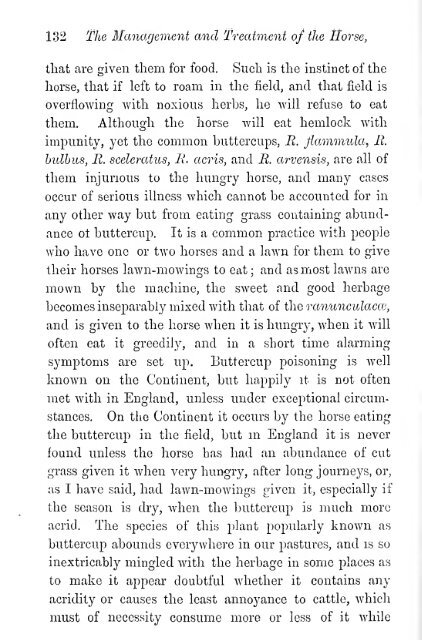The management and treatment of the horse in the stable, field, and ...
The management and treatment of the horse in the stable, field, and ...
The management and treatment of the horse in the stable, field, and ...
You also want an ePaper? Increase the reach of your titles
YUMPU automatically turns print PDFs into web optimized ePapers that Google loves.
132 <strong>The</strong> Management <strong>and</strong> Treatment <strong>of</strong> <strong>the</strong> Horse,<br />
that are given <strong>the</strong>m for food. Such is <strong>the</strong> <strong>in</strong>st<strong>in</strong>ct <strong>of</strong> <strong>the</strong><br />
<strong>horse</strong>, that if left to roam <strong>in</strong> <strong>the</strong> <strong>field</strong>, <strong>and</strong> that <strong>field</strong> is<br />
overflow<strong>in</strong>g with noxious herbs, he will refuse to eat<br />
<strong>the</strong>m. Although <strong>the</strong> <strong>horse</strong> will eat hemlock with<br />
impunity, yet <strong>the</strong> common buttercups, R. Jiammula, R,<br />
bulbus, R. sceleratus, R. acris, <strong>and</strong> R. arvensis, are all <strong>of</strong><br />
<strong>the</strong>m <strong>in</strong>jurious to <strong>the</strong> hungry <strong>horse</strong>, <strong>and</strong> many cases<br />
occur <strong>of</strong> serious illness which cannot be accounted for <strong>in</strong><br />
any o<strong>the</strong>r way but from eat<strong>in</strong>g grass conta<strong>in</strong><strong>in</strong>g abund-<br />
ance o± buttercup. It is a common practice with people<br />
who have one or two <strong>horse</strong>s <strong>and</strong> a lawn for <strong>the</strong>m to give<br />
<strong>the</strong>ir <strong>horse</strong>s lawn-mow<strong>in</strong>gs to eat; <strong>and</strong> as most lawns are<br />
mown by <strong>the</strong> mach<strong>in</strong>e, <strong>the</strong> sweet <strong>and</strong> good herbage<br />
becomes <strong>in</strong>separably mixed with that <strong>of</strong> <strong>the</strong> ranunculacce,<br />
<strong>and</strong> is given to <strong>the</strong> <strong>horse</strong> when it is hungry, when it will<br />
<strong>of</strong>ten eat it greedily, <strong>and</strong> <strong>in</strong> a short time alarm<strong>in</strong>g<br />
symptoms are set up. Buttercup poison<strong>in</strong>g is well<br />
known on <strong>the</strong> Cont<strong>in</strong>ent, but happily it is not <strong>of</strong>ten<br />
met with <strong>in</strong> Engl<strong>and</strong>, unless under exceptional circum-<br />
stances. On <strong>the</strong> Cont<strong>in</strong>ent it occurs by <strong>the</strong> <strong>horse</strong> eat<strong>in</strong>g<br />
<strong>the</strong> buttercup <strong>in</strong> <strong>the</strong> <strong>field</strong>, but <strong>in</strong> Engl<strong>and</strong> it is never<br />
found unless <strong>the</strong> <strong>horse</strong> has had an abundance <strong>of</strong> cut<br />
grass given it when very hungry, after long journeys, or,<br />
as I have said, had lawn-mow<strong>in</strong>gs given it, especially if<br />
<strong>the</strong> season is dry, when <strong>the</strong> buttercup is much more<br />
acrid. <strong>The</strong> species <strong>of</strong> this plant popularly known as<br />
buttercup abounds everywhere <strong>in</strong> our pastures, <strong>and</strong> is so<br />
<strong>in</strong>extricably m<strong>in</strong>gled with <strong>the</strong> herbage <strong>in</strong> some places as<br />
to make it appear doubtful Avhe<strong>the</strong>r it conta<strong>in</strong>s any<br />
acridity or causes <strong>the</strong> least annoyance to cattle, which<br />
must <strong>of</strong> necessity consume more or less <strong>of</strong> it while
















